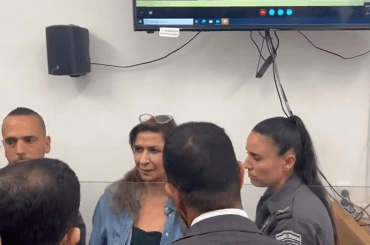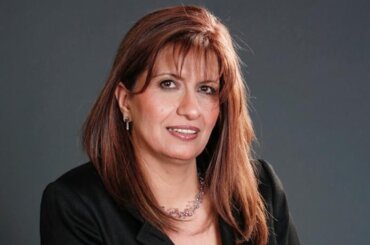TOWERS OF IVORY AND STEEL
How Israeli Universities Deny Palestinian Freedom
by Maya Wind
288 pp. Verso Press, $29.95
Little by little, state legislatures across the United States are intervening in university practices like tenure and DEI. Recently, Indiana’s House of Representatives has been trying to legislate “intellectual diversity” by mandating that scholars share a variety of perspectives that can be evaluated when they are up for review. On a national level, elite institutions have come under fire if their administration isn’t sufficiently Zionist.
Government encroaching on the sacred cow of academic freedom is precisely the way the Israeli government intervenes in the lives of faculty and students. The difference is that, in Israel, such interference is baked into the system. That’s why Maya Wind’s Towers of Ivory and Steel: How Israeli Universities Deny Palestinian Freedom is a critical tool for anyone affiliated with academic life — students, faculty, or staff. It is also a text that people involved in the boycott, divestment, and sanctions (BDS) movement will find essential: its systematic analysis, history, and solid data are the ammunition we need to combat those who mistakenly assume that boycotting Israeli academic institutions undermines academic freedom.

Wind’s book is structured in two parts — complicity and repression. It opens and concludes with two brilliant essays by Nadia Abu El-Haj and Robin D. G. Kelley. Wind’s first section lays out the creation of Israeli academic institutions as foundations for the militarized settler colonial state while the second half covers how those institutions implement apartheid and suppress Palestinian students and faculty. From the outset, Wind is refreshingly unequivocal: “Israeli universities are not independent of the Israeli security state but, rather, serve as an extension of its violence” (p. 13). Throughout her book, readers glean insight into how Israeli universities create the knowledge necessary to rationalize and legalize Israel’s apartheid regime.
The compiled evidence in Wind’s powerful book includes a variety of materials that are accessible to an Ashkenazi Israeli like Wind, albeit one whose struggle against Zionism began when she was a teenager, including her refusal to serve in Israel’s army. Relying upon research produced by Palestinian scholars and activists, coupled with documents from Israeli state and military archives, Wind reveals precisely how Israeli universities are complicit in the violation of Palestinian rights inside and outside academia.
The university and the colony
Grounding the role of Israeli universities in settler colonialism, Wind illustrates that “before even the founding of Israel, the Zionist movement founded three universities, which were explicitly to serve the movement’s territorial objectives in Palestine.” (p. 23)
The Hebrew University (1918) was designed to be a “strategic outpost for the Zionist movement and to stake a symbolic political claim to Jerusalem,” while the Technion (1925) and the Weizmann Institute (1934) were “established to advance the scientific and technological development of Israel” (p. 23).
Each institution participated in the Nakba by hosting the Haganah’s “Science Corps, which opened bases on all three campuses to research and refine military capabilities” (p. 23). Faculty and students participated in the production of arms and biological weapons on their campuses, serving Zionist militias that would expel and massacre Palestinians. Science Corps was later incorporated into the Ministry of Defense and led to the creation of Israel’s leading weapons manufacturers, such as Rafael and Israeli Aerospace Industries — a consequence of the commingling of academia and the state. As Wind explains, “The Israeli state’s military industries and its universities have always been co-constituted. Universities have birthed, funded, and advanced their scientific research through the Israeli security state and Israeli weapons corporations.” (p. 105)
While one arm of Israeli academia has certainly been fixated on building its arsenal, its other arm has centered on advancing its demographic and territorial expansionist project: “Their campuses, research, and architectural and planning expertise have been committed toward the state’s territorial and demographic project.” (p. 60) In other words, Israeli universities are part and parcel of the Judaization process. Whether it’s occupying lands in Sheikh Badr or Issawiyeh for Hebrew University’s West and East Jerusalem campuses, all universities in Israel have annexed Palestinian land. Police outposts in university neighborhoods coordinate with campus security, “made up of former Israeli combat soldiers, many of whom still serve in combat reserve units” and police Palestinians on and off campus. (p. 148) It’s not too far-fetched to see the parallels between urban American universities and their role in the gentrification and policing of inner-city communities.
But Israeli universities are not only fixated on annexation near the Green Line. The University of Haifa “was designed to further Israel’s regional demographic project” (p. 71) on the land of al-Khureiba. Its “departments of urban planning and geography have contributed their expertise to assess, improve, and design ‘Judaization’ policies.” (p. 72) The scholarly output of its faculty has contributed to policies supporting the Ministry of Defense that “construct scholarly justifications for the expulsion, containment, and discrimination of Palestinian citizens, alongside exclusive and increased investment in Jewish settlements in the Galilee.” (p. 73)
Similarly, “Ben-Gurion University was established in 1969 with the explicit goal to ‘develop the Negev’ and, as the Zionist adage puts it, ‘make the desert bloom.’” (p. 76) As in the Galilee, Israel worked to contain the Palestinian Bedouin population by shrinking access to their land and re-settling it with its lesser desired Jewish people — initially, Arab and Indian — to the Naqab desert.
Israel’s most recent university came into existence in exactly the same manner as those that came before it — on stolen land from Palestinian villages like Kifl Hares and Marda. As Wind highlights, Ariel University’s foundation has the exact same agenda as its counterparts. Indeed, Ariel is seen as a progenitor for solidifying the annexation of much of the West Bank. It “transformed…Israeli public perception from an illegal and heavily militarized settlement into a suburb of Tel Aviv.” (p. 81) The university and the settlement are mutually reinforcing: “The institution confers degrees as a means of expanding Israeli sovereignty and advancing the annexation of the OPT.” (p. 84)
The university-military-industrial complex
Wind does an excellent job of demonstrating how institutions were created to serve Zionist aims, but it’s especially intriguing to read about the ways in which a wide variety of academic disciplines participate in the creation of facts on the ground for the Israeli state: archaeology, law, philosophy, Middle East studies, history, sociology, architecture, anthropology, politics and government, cultural studies, and specialty programs that fuse military and academic work with the high tech sector. Using evidence from each discipline, Wind illustrates the historical and ongoing use of how academia works to displace and disrupt Palestinian lives.
In some fields, like Middle East studies, the revolving door for employees between the state, the corporation, and the university enables the development of its university-military-industrial complex: “This entanglement of university, military, and state expertise shaped the discipline in its early years. Many of the founding Israeli Middle East studies scholars moved between or held parallel roles in academia and the security establishment or were otherwise bound by loyalty and secrecy commitments to state apparatuses.” (p. 49) Of the various contributions such intermixing facilitated was Tel Aviv University’s faculty preventing the return of Palestinian refugees after the passage of UN Resolution 194.
Collusion between the state and academia plays out today in the creation of programs such as Hebrew University’s Havatzalot intelligence program. The university was required to make concessions to host the program, including “far-reaching Israeli military intervention in the program’s content, structure, employees, and infrastructure on campus.” (p. 53) Palestinian students protested this program, including screening a film documenting what it felt like to encounter Havatzalot students in their classrooms; their actions garnered reprimands — including calls for criminal investigations from the Knesset. These actions ring true as we witness Congress’s overstepping by investigating university campus responses to Israel’s genocidal war on Gaza.
Repressing Palestinian students
Importantly, the treatment of Palestinian students takes up a critical portion of Wind’s book, especially the education sector more broadly, as it affects Palestinian citizens of Israel and their teachers, both of whom have undergone decades of surveillance and discrimination. Even secondary education in Israel has largely been the purview of the security state. Wind shares that “as recently as 2020, the director general of the Ministry of Education met with the Shin Bet to discuss screening Palestinian citizen teachers for ‘radicalism.’” (p. 137)
Acceptance into Israeli universities requires surmounting various hurdles, including having matriculated at underfunded schools, passing psychometric exams in addition to quotas for programs like medicine, and the rote racism applied to citizens who aren’t Jewish. For those who make it through these hoops and enroll in an Israeli university, there are daily barriers to contend with, from being accepted into student housing to facing harassment on campus. When they attempt to challenge these policies, Israeli universities never side with their Palestinian students: “What remains unaddressed and unspeakable for university administrations is their alignment and collaboration with the Israeli regime of discriminatory policies.” In fact, on an Israeli campus, Wind tells us, “Palestinian identity itself has always been conceived of as a ‘security threat.’” (p. 146)
Enabling suppression of Palestinian student expression, especially those who engage in campus activism, is Im Tirtzu, an organization affiliated with the Likud that seeks to “monitor ‘leftist’ Jewish faculty and intimidate Palestinian student groups,” maintaining branches on all Israeli university campuses. (p. 117) Faculty are not immune to such surveillance if their research and teaching threaten the state; Im Tirtzu’s informing led to the expulsion of political scientists Haim Yacobi and Neve Gordon from Ben-Gurion University. Of course, the work of Ilan Pappé and his student, Theodore Katz, at the University of Haifa are two additional notorious examples discussed by Wind.
Wind also covers Palestinian university education more broadly, including Israeli interference with the creation and running of universities in the West Bank and Gaza. Monitoring student activism on campuses in the West Bank has often led to violent military repression — monitoring that is enabled by the knowledge and weapons produced by Israel’s university-military-industrial complex. Such oppression is directly tied to the university-to-prison pipeline that many Palestinians endure at the hands of Israel’s apartheid regime.
According to Wind’s research, “no Israeli university president or senior administrator has offered to intervene” on behalf of Palestinian faculty or students facing Israeli military invasions of their campuses. Indeed, “Tel Aviv University president even called in 1986 for Birzeit [University] to be closed by the Israeli military government.” (p. 166) As Wind meticulously chronicles, there is a deafening silence within the halls of Israeli academia to any violation of a Palestinian’s right to education. That alone should be a call to arms for joining the academic boycott.
These instances and histories, which are also very much in the present reality of Israeli academia, should be reason enough for academics to join the boycott movement as individuals and as members of professional organizations. Wind’s book is crystal clear: “Israeli universities continue not only to actively participate in the violence of the Israeli state against Palestinians but also to contribute their resources, research, and scholarship to maintain, defend, and justify this oppression.” (p. 178)



“Israeli universities are not independent of the Israeli security state but, rather, serve as an extension of its violence”.
Israeli universities serve as headhunter to feed young radicalized rabbinate into orthodox synagogues across US. Southern Poverty Law Center’s Hate map drives Xtreme orthodox crazy. It’s absurd and comical to witness orthodox hide their violent support of ‘settlement’ under the cover of co-opted civil rights language especially in MLKjr’s hometown. Now they call their hate groups: ‘grassroots coalitions’ instead of blablaconservatives. Pay attention: cross-pollination between violent West Bank settlement terrorist and US orthodox is vital.
This rings entirely true. However, to use this – and it is right to do so – as a basis for boycotting Israeli higher education should bring into focus the worldwide Military-Industrial-Academic-Political-Scientific Complex. Report after report shows the deep inroads that the military has made into higher education here in the UK, in the USA and I suspect in Russia, China, India and everywhere else. Imperialist capitalism and its only slightly different counterparts in Russia and China demand a constant flow of highly-educated students to keep the wheels turning. It’s up to us, the working class, to end that. Boycotting Israeli universities will inevitably bring counter-arguments about hypocrisy and double standards. How are those to be answered?